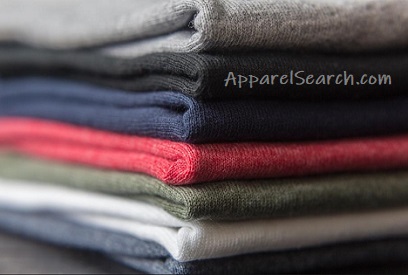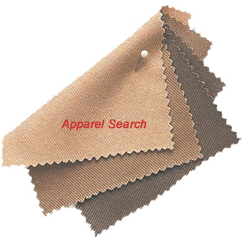Textiles and the Textile Industry by Apparel Search
 Welcome to the textile section of the Apparel Search
Directory. In this area we present information and resources about the textile
market. This includes educational resources regarding fabrics, fibers, mill
machinery, manufacturing best practices, and other industry relevant products
and services. If you have suggestions in regard to additional directory
topics that should be added to this section, please do not hesitate to let
us know your thoughts.
Welcome to the textile section of the Apparel Search
Directory. In this area we present information and resources about the textile
market. This includes educational resources regarding fabrics, fibers, mill
machinery, manufacturing best practices, and other industry relevant products
and services. If you have suggestions in regard to additional directory
topics that should be added to this section, please do not hesitate to let
us know your thoughts.
Fabric Definitions
Textile Intelligence Research Reports
 The
textile industry is a very important segment of the international economy.
Textiles are also very important to people that utilize fabric and textile
trimming in association with their hobbies. We hope that this page
helped you learn about more about textiles and the textile industry.
The
textile industry is a very important segment of the international economy.
Textiles are also very important to people that utilize fabric and textile
trimming in association with their hobbies. We hope that this page
helped you learn about more about textiles and the textile industry.
Are you a textile designer? If yes, you probably would like to join the textile designers group at the Fashion Industry Network.
You can also learn about fabrics in our fashion industry terms section. For example, you can find the answer to the question, What are performance fabrics?
The textile industry is a critical sector that encompasses the production of fibers, fabrics, yarns, and the subsequent manufacturing of various textile products. It plays a pivotal role in the global economy, particularly in the context of the apparel market.
International Textile Industry and the Apparel Market
The international textile industry is a vast and dynamic sector, closely linked to the apparel market. It operates on a global scale, with major players located in regions such as Asia, Europe, and the Americas. Countries like China, India, Bangladesh, Vietnam, and Turkey are significant hubs for textile and apparel production due to their abundant labor, technical capabilities, and infrastructure.
In the apparel market, trends and consumer preferences continually evolve, impacting the demand for various textile products. Sustainability and ethical sourcing have gained substantial importance in recent years, with consumers showing a growing interest in eco-friendly and ethically produced garments.
Technological advancements, such as automation, digital printing, and innovative materials, have revolutionized the industry, making production faster, more efficient, and environmentally sustainable. E-commerce has also disrupted traditional retail, providing new channels for the distribution of apparel globally.
USA Textile Industry Transformation
The USA has a rich history in the textile industry, dating back to the 19th century. During the industrial revolution, the USA became a major textile producer, with regions like New England and the South emerging as significant textile manufacturing centers. However, over the decades, the landscape of the USA textile industry has transformed drastically.
In the latter part of the 20th century, the USA faced significant challenges due to globalization. Lower labor costs and less stringent environmental regulations in other countries led to a shift in textile production to nations with lower production costs. Consequently, the USA experienced a decline in its textile manufacturing base, and many companies moved their operations overseas.
In recent years, there has been a resurgence of interest in domestic manufacturing due to factors like rising labor costs in certain overseas locations, concerns about supply chain disruptions, and a growing focus on sustainability. Some companies are returning or reshoring their production back to the USA, leveraging automation and advanced technologies to enhance efficiency and productivity.
Key Aspects of the Textile Industry in Fashion & Footwear
Materials and Fabrics: The textile industry is at the core of fashion
and footwear, providing a diverse range of materials and fabrics. From
natural fibers like cotton, wool, and silk to synthetic fibers such as
polyester and nylon, the choice of material significantly influences the
design, comfort, and functionality of clothing and footwear.
Design and Innovation: Designers constantly experiment with textiles, integrating technology and innovation to create cutting-edge designs. Advanced textile technologies enable the development of smart fabrics, performance-enhancing materials, and sustainable alternatives that cater to the evolving demands of consumers.
Sustainability and Ethical Practices: Sustainable and ethical considerations are paramount in the modern textile industry. Sustainable practices, including recycling, use of organic materials, and reducing waste, are increasingly important for both consumers and manufacturers. Ethical sourcing and fair labor practices are essential for a responsible and transparent supply chain.
Manufacturing and Supply Chain: Streamlining the manufacturing process, optimizing the supply chain, and minimizing lead times are crucial aspects of the textile industry. Efficient production and timely delivery are essential to meet consumer demand and stay competitive in the fashion and footwear market.
Consumer Trends and Market Dynamics: Understanding consumer preferences, market trends, and regional variations is vital for success in the fashion and footwear sectors. Industry players need to adapt to changing tastes, cultural influences, and emerging trends to create products that resonate with consumers.
The textile industry is a multifaceted sector at the heart of the global fashion and footwear markets. Evolving technologies, changing consumer preferences, sustainability concerns, and the shift in manufacturing centers continue to shape the industry's landscape and dynamics.
Learn about dress shirt fabrics and suit fabrics on our Fashion Blog.
Textile Links:
Check out a few Textile Industry websites of relevance:
College of Textiles at NC State University
Office of Textiles and Apparel
U.S. Department of Labor Safety and Health Topics Relevant to Textiles
Thank you for using the Apparel Search website to learn more about fabrics used in our industry. If you have questions regarding knits, wovens, or nonwovens, you are welcome to join in the discussions and ask your questions at the Fashion Industry Network.